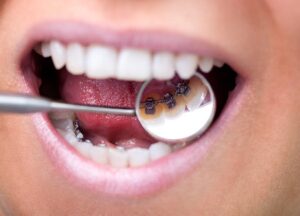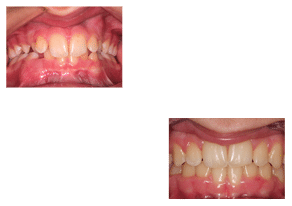Lingual braces are a popular choice for people who want straighter teeth without the look of traditional braces. Since they're placed behind the teeth, they stay hidden from view. That simple design difference has made them a go-to option for adults and teens who prefer a more private treatment. Find a clear look at the pros and cons of lingual braces, how they work, who they’re for, and what to expect if you choose them.
Orthodontic treatment has come a long way. You now have more control over how your smile is corrected—and how visible that process is. But choosing the right treatment means understanding both the benefits and the trade-offs.
What Are Lingual Braces and How Do They Work?

Lingual braces are similar to traditional metal braces, but they’re placed on the inside surface of your teeth, facing the tongue. That makes them invisible from the front when you smile or speak.
Here's how they function:
-
Placement: The brackets and wires are attached to the back of your teeth instead of the front.
-
Customization: They are designed specifically for each patient’s mouth to ensure precise tooth movement.
-
Movement: Just like traditional braces, they apply continuous pressure to move teeth into the correct position over time.
Orthodontists often use lingual braces to treat common issues like crowding, spacing, overbites, and underbites. The treatment time is similar to that of traditional braces, but it depends on the complexity of the case.
While they’re less visible, lingual braces require skill to place and adjust. Not every orthodontist offers them, so it’s important to find someone with experience in this type of system.
Benefits of Lingual Braces
Choosing this treatment comes with several benefits that go beyond appearance. For many patients, the biggest draw is how discreet they are—but that’s just the start. Here are some of the most common advantages:
Hidden from View
Lingual braces are placed behind your teeth, so no one can see them when you smile. This makes them a great choice for professionals, performers, or anyone who prefers a more private treatment option.
Effective for Complex Cases
These braces are just as effective as traditional ones when it comes to fixing complicated dental issues. They can correct bite problems, rotate teeth, and close large gaps.
Customized for Precision
Each bracket is made to fit the shape of your teeth. That level of fit helps with comfort and improves how your teeth shift over time.
Reduced Risk of Visible Stains
Because the brackets sit behind your teeth, there’s no risk of front-side staining or marks. That helps keep your visible smile looking clean during treatment.
No Interruption to Facial Appearance
There are no visible wires or brackets to adjust to in photos or daily conversation. This gives you more confidence, especially in social or work settings.
While these benefits are appealing, it’s also important to weigh them against the potential downsides.
Downsides to Consider Before Choosing Lingual Braces
While lingual braces offer a discreet way to straighten teeth, they also come with a few drawbacks. It’s important to understand these before making a decision. Here’s what patients often experience:
1. Tongue Discomfort
The brackets sit close to the tongue, which can cause irritation, especially in the early stages. Some patients report soreness or small cuts as their mouth adjusts.
2. Speech Changes
You might notice a slight lisp or change in how you pronounce certain words at first. Most people adapt after a few weeks, but it can be noticeable during the adjustment period.
3. More Challenging to Clean
Because of where lingual braces are placed, brushing and flossing take more time and care. Food and plaque can build up around the brackets if not cleaned properly.
4. Higher Cost
Lingual braces often cost more than traditional braces or clear aligners. This is due to the customization involved and the additional time required for treatment and appointments.
5. Longer and Less Comfortable Appointments
Placing and adjusting the brackets can take more time. It’s also harder for your orthodontist to access the back of your teeth, which can make appointments slightly longer.
These downsides don’t mean lingual braces are a bad choice—they just highlight the need for a realistic view of what to expect.
Who Is a Good Candidate for Lingual Braces?
Lingual braces aren’t the right fit for everyone, but they work well for many people looking for discreet orthodontic treatment. Here’s a look at who might benefit most from this option:
Adults and Older Teens
Those who are concerned about appearance during treatment often prefer lingual braces. Adults in professional environments and teens involved in social or performance-based activities tend to find them appealing.
People with Mild to Moderate Bite Issues
Lingual braces are effective for treating a wide range of alignment problems, but they’re especially suited for cases that don’t require major jaw adjustments. Common issues they address include:
-
Crowded or rotated teeth
-
Gaps or spacing
-
Mild overbites and underbites
Patients Who Prioritize Aesthetics
If the look of braces is a major concern, lingual braces offer a near-invisible solution. They allow you to go through treatment without any noticeable hardware.
Individuals with Good Oral Hygiene
Since cleaning lingual braces takes more effort, they’re better for those who are consistent with brushing and flossing. This helps prevent buildup around the hidden brackets.
Not Ideal for Small Teeth or Certain Bites
People with very small teeth or deep bites might find lingual braces uncomfortable or difficult to fit. An orthodontist will need to assess your case to determine if it’s a workable option.
Comparing Lingual Braces to Other Orthodontic Options
When deciding on the right treatment, it helps to see how lingual braces compare to other popular options. Each has its strengths and challenges. Below is a side-by-side look at how they stack up:
Lingual Braces vs. Traditional Braces
| Feature | Lingual Braces | Traditional Braces |
|---|---|---|
| Visibility | Hidden behind teeth | Clearly visible on front |
| Comfort | May cause tongue irritation | May cause cheek irritation |
| Cost | Higher | More affordable |
| Customization | Fully customized brackets | Standard brackets |
| Cleaning | More difficult | Easier to clean around |
Lingual Braces vs. Clear Aligners
| Feature | Lingual Braces | Clear Aligners |
|---|---|---|
| Visibility | Not visible | Nearly invisible |
| Comfort | Fixed, may cause irritation | Removable, smooth plastic |
| Discipline | No user control needed | Requires patient compliance |
| Cost | Typically higher | Varies depending on case |
| Best for | Complex tooth movements | Mild to moderate alignment |
Summary: When to Choose Each
-
Lingual braces: Best for those who want powerful correction without visible brackets.
-
Traditional braces: Great for patients who need strong results and don’t mind visibility.
-
Clear aligners: Ideal for those who want removable, low-profile treatment and are committed to wearing them consistently.
Final Thoughts: Are Lingual Braces Right for You?
Lingual braces offer a unique mix of discretion and strength. They can fix many of the same dental problems that traditional braces handle, but without the visible hardware. For people who are self-conscious about appearance during treatment, this option provides real value.
Still, there are clear trade-offs. Lingual braces tend to be more expensive. They can affect your speech and require more effort to clean. That’s why it’s important to weigh both the benefits and the challenges before making a decision.
If you’re considering lingual braces, the best next step is to talk with an experienced orthodontist. A professional can assess your smile and let you know if this type of treatment fits your needs. Everyone’s mouth is different, so getting a clear recommendation is key to moving forward with confidence.
Frequently Asked Questions
Here are some of the most common questions patients ask before starting treatment with lingual braces. These answers can help you feel more informed as you think about your options.
How long does treatment with lingual braces take?
The length of treatment varies based on your dental needs. On average, it can take 18 to 36 months. Complex cases may take a little longer, while minor corrections may be quicker.
Are lingual braces more painful than regular braces?
Discomfort is normal with any type of braces, especially at the start. Lingual braces may cause more irritation to the tongue, but this usually fades within a few weeks as your mouth adjusts.
Will lingual braces affect how I speak?
Some patients notice a slight lisp or speech change when they first get lingual braces. This typically improves after a short adjustment period.
Can I eat normally with lingual braces?
Yes, but you’ll need to avoid sticky, hard, or chewy foods. These can damage the brackets or make cleaning more difficult.
Are lingual braces harder to clean?
They do require more attention during brushing and flossing since the brackets are harder to see and reach. Using floss threaders or water flossers can help.
Do all orthodontists offer lingual braces?
No, not all do. Because they require special training and tools, you’ll need to find an orthodontist who offers this service and has experience with it.
Take the Next Step Toward a Discreet and Confident Smile
If you’ve been thinking about the benefits and challenges of lingual braces, a one-on-one consultation can help you move forward with clarity. At Monmouth Ocean Orthodontics, we offer personalized treatment plans designed around your comfort, lifestyle, and smile goals.
With decades of experience and advanced technology, our team delivers efficient, precise care for every patient. Whether you’re considering lingual braces or exploring other options, we’ll walk you through the details so you can make an informed choice.
Book your consultation with Monmouth Ocean Orthodontics today. Use the form on our site or give us a call to get started—we’re here to support your smile from day one.





